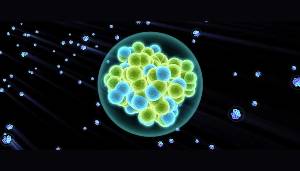May 5 2014
Element 117, first discovered by Lawrence Livermore scientists and international collaborators in 2002, is one step closer to being named.
 Element 117, first discovered by Lawrence Livermore researchers and Russian collaborators, has been reproduced by an international consortium. The International Union of Pure and Applied Chemistry (IUPAC) must accept the confirmation before the element is named.
Element 117, first discovered by Lawrence Livermore researchers and Russian collaborators, has been reproduced by an international consortium. The International Union of Pure and Applied Chemistry (IUPAC) must accept the confirmation before the element is named.
The existence of element 117 and its decay chain to elements 115 and 113 have been confirmed by a second international team led by scientists at GSI Helmholtz Centre for Heavy Ion Research, an accelerator laboratory located in Darmstadt, Germany. The research will appear in an upcoming issue of the journal, Physical Review Letters.
The next step is for the International Union of Pure and Applied Chemistry (IUPAC) to accept the confirmation. The IUPAC will review the new findings and the original research and decide whether further experiments are needed before acknowledging the element's discovery. After acceptance, IUPAC would determine which institution may propose names.
In the German experiments, scientists bombarded a berkelium target with calcium ions until they collided and formed element 117. Element 117 then decayed into elements 115 and 113. Livermore researchers Narek Gharibyan and Dawn Shaughnessy and former postdoc Evgeny Tereshatov participated in the German experiment.
Lawrence Livermore teamed with the Joint Institute for Nuclear Research in Russisa (JINR) in 2004 to discover elements 113 and 115. The LLNL/JINR team then jointly worked with researchers from the Research Institute for Advanced Reactors (Dimitrovgrad), Oak Ridge National Laboratory, Vanderbilt University and the University of Nevada, Las Vegas, to discover element 117 in 2010.
Elements beyond atomic number 104 are referred to as superheavy elements. The most long-lived ones are expected to be situated on a so-called "island of stability," where nuclei with extremely long half-lives should be found.
Although superheavy elements have not been found in nature, they can be produced by accelerating beams of nuclei and shooting them at the heaviest possible target nuclei. Fusion of two nuclei – a very rare event – occasionally produces a superheavy element. They generally only exist for a short time.